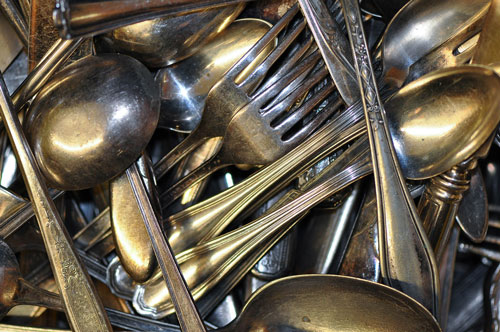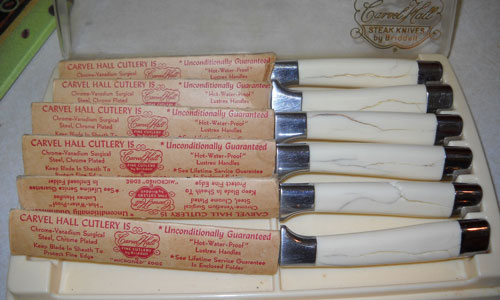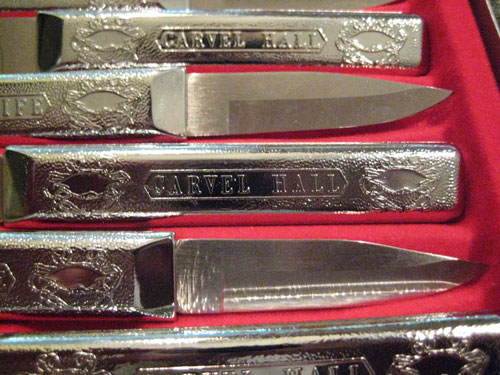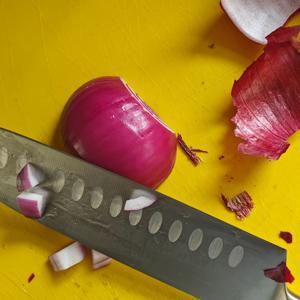Never A Dull Moment
How sharp knives disappeared from the dining room table, only to return, centuries later, in steak knife form. Kings, cardinals, and factories are involved.
Need some sharp blades in your life? Be sure to check out our review of the Imarku knife blade set, which you can check out over here. No matter the season—and whether you’re an experienced cook or barely know what you’re doing—learn about some sharp blades from a dull guy.

How we imagined Cardinal Richelieu broached the subject: "How many times do I have to tell you hosers, don't pick your teeth with a knife!" (Wikimedia Commons)
How etiquette led dining-room knives to lose their sharp edges
Of course, before there was the steak knife, there was the table knife, or the butter knife. As blade designs go, it’s pretty weaksauce, and intentionally so.
The reason for this goes back nearly 400 years, and involves an annoyed French clergyman. Cardinal Armand Jean du Plessis, the Duke of Richelieu and Fronsac—or Cardinal Richelieu for short—became annoyed by table manners of those eating with pointed knives, which were used as a way of picking teeth.
He had his knife edges rounded, the legend goes, in an effort to discourage bad behavior by his guests.
This broke tradition around knife use. See, knife blades were long the primary way that people ate food—unlike napkins, which weren’t always a given, they were always a key element of the meal. Often, medieval cultures would eat meals using a single knife—their own, which they brought with them to dinner—and their hands. The introduction of the fork into European culture changed the way we interacted with knives, just as it did with napkins.
Cardinal Richelieu was a powerful, influential man, and his knife-dulling approach gained enough currency that in 1669, 27 years after he died, King Louis XIV issued a decree making pointed knives illegal in France, whether inside the home or out in public. Suddenly, a lot of sharp knives got pretty dull.

Sorry, couldn't find a knife in my junk drawer. (MarkMartins/Pixabay)
That decision, notes Henry Petroski’s The Evolution of Useful Things, had a long-term effect on the knife’s evolution from the pocket to the table:
Such actions, coupled with the growing widespread use of forks, gave the table knife its now familiar blunt-tipped blade. Toward the end of the seventeenth century, the blade curved into a scimitar shape, but this contour was to be modified over the next century to become less weaponlike. The blunt end became more prominent, not merely to emphasize its bluntness but, since the paired fork was likely to be two-tined and so not an efficient scoop, to serve as a surface onto which food might be heaped for conveying to the mouth.
The pocket knife, of course, never went away, and honestly, nor did the need to have a sharp blade at the table.
But it would take until the middle of the 20th century for the proper tool to truly gain popularity.
“Every time I design a handle, I go through the same door. How the door was found, I do not know.”
— Thomas Lamb, a 20th-century industrial designer, discussing his work with handles in the magazine Industrial Design. Lamb became well-known in the years after World War II for his years of research into handle design, the primary result of which, the wedge-lock handle, became so well-known that he had a display of his work at the Museum of Modern Art in 1948. He received a patent for a cutlery handle in 1954, around which time he licensed his work to a company called Alcas, which released a line of knives called Cutco in 1952. Yes, the same Cutco that people sell door-to-door—and uses that handle design today.

Carvel Hall's famous steak knives—with the blades covered and the handles cracked. They're old! (Vintage Sailor/Flickr)
How sharp knives found their way back to the table in the modern era
Obviously, sharp knives never really went away—people in the kitchen needed blades with an edge to them if they were going to prepare food.
But what might be surprising to an observer is that steak knives, at least in terms of how we consider them in the modern day, aren’t old innovations with centuries of history. In fact, the modern steak knife didn’t truly make itself known until after World War II.
A device of simple design and surprising sharpness, the turning point for the steak knife came in the form of a reconstituted letter opener. That letter opener, designed by a Maryland machinist named Paul C. Culver in 1946, was originally a gift for businessman Charles D. Briddell Jr.
Briddell’s father, Charles Sr. was a man who chose blacksmithing over farming as a teenager, eventually turning his preferred career path into a namesake company. It was already a quickly growing company by the mid-1940s, with the company’s Crisfield, Maryland factory building equipment during World War II.
The company was also involved in manufacturing cutlery at the time, which is perhaps why the gift from Culver proved particularly fruitful for the Briddell family, especially after Charles Jr.’s brother, Tom, saw the delicate craftsmanship of the knife and realized it made more sense on the dinner table than as a tool for opening letters.
According to a 1953 article from the The Salisbury Times, Tom Briddell asked Culver for both a set of six steak knives and a case to put them in, then did a nationwide survey of the potential market. The findings were clear: People wanted an elegant, sharp knife to cut their meat, and they wanted it at home, rather than a restaurant. The resulting knife, the Carvel Hall, soon went on sale nationally—and became the first common kind of steak knife you could buy.
One early ad put the benefits of the $16.50 steak knife set as such:
Now you can do what famous chop houses do when they serve meat: Put a lovely steak knife at each place. The new Carvel Hall, worthy companion to the finest table silver, is a knife of sheer utility. Slimly graceful though it is, its long, tapering bald of finest steel cuts through the thickest steak with ease. Every home needs this smart steak knife set.
By the time of the 1953 article, Culver’s handmade letter opener had become a $3 million business.

Carvel Hall crab knives. (Dave Woodward/Flickr)
Eventually, the company, once named for the elder Briddell, would gain the Carvel Hall name, and (because it was a Maryland company) it would become known regionally for an ornate crab knife design.
But as the Briddell family aged out of the firm, the company did not always have things easy. The company, on the Eastern Shore of Maryland, shuttered its doors in 1989 after its corporate parent filed for bankruptcy, but came back to life in 1990 after another company purchased the brand and reopened the factory. In an area with a low population and without a lot of manufacturing jobs, the reopening was a bit of a godsend.
"Carvel Hall will by itself represent a potential decrease of one percent in unemployment," Somerset County Director of Economic Development Tom Laidlaw told The Washington Post that year.
Ultimately, it was not to last. In 2000, the factory closed entirely, getting sold to an aerospace firm in 2004 but ultimately failing to keep its doors open.
The closed factory is giving the nearby community a lot of headaches as local leaders try to figure out what they can do with this massive building, with one suggestion that gained attention being the idea of using the factory to convert chicken manure into energy.
Eventually, the thing that won out was a redevelopment project for the company Element MD, which specializes in producing cannabis edibles.
Turns out, all the jobs that were once in knives are now in pot.
“Knives that have the quality of steel but can maintain a sharp edge are prized by most good cooks. And when they can be handsomely and conveniently displayed, they take on even more importance.”
— Los Angeles Times Home magazine columnist Joan Dektar, discussing a few early examples of the slotted knife block in a 1975 story. This device, while a fairly common kitchen mainstay these days (thanks to the fact that it’s a naturally good place to store knives), doesn’t appear to have caught on in its current form until the late 1970s, meaning that for decades, people were storing their knives in very awkward ways. While many of the highlighted examples by Dektar, produced by Chicago Cutlery, were for larger knives, the company did also produce a set for steak knives with a built-in sharpener. These days, the peak of knife-block technology is the bamboo organizer, which replaces set slots with hundreds of bamboo rods, allowing you to put your knives in any way you want.
Of course, some might point out (pun intended) that steak knives and regular butter knives don’t have all that many differences when you break them down, and you’d probably be right to some degree.
One is sharper than the other, but when it comes down to eating your food, they both cut to varying degrees and they both spread to varying degrees.
In fact, the food and technology company ChefSteps actually suggested, as part of its knife-sharpening lessons, that you can actually turn butter knives into steak knives with a set of Japanese waterstones or a grinder.
This sounds like a quick-and-dirty DIY project in the best way possible. In fact, the first half of the video just shows a guy walking through Goodwill, buying old sets of butter knives.
Considering the roots of the modern steak knife come from a knife put to use in an entirely different context, this is basically the perfect second life for cheap cutlery.
--
Find this one an interesting read? Share it with a pal! And if you wanna read more knife content, I have some of that over this way.
:format(jpeg)/2017/08/tedium082217.gif)
/2017/08/tedium082217.gif)


/uploads/ernie_crop.jpg)